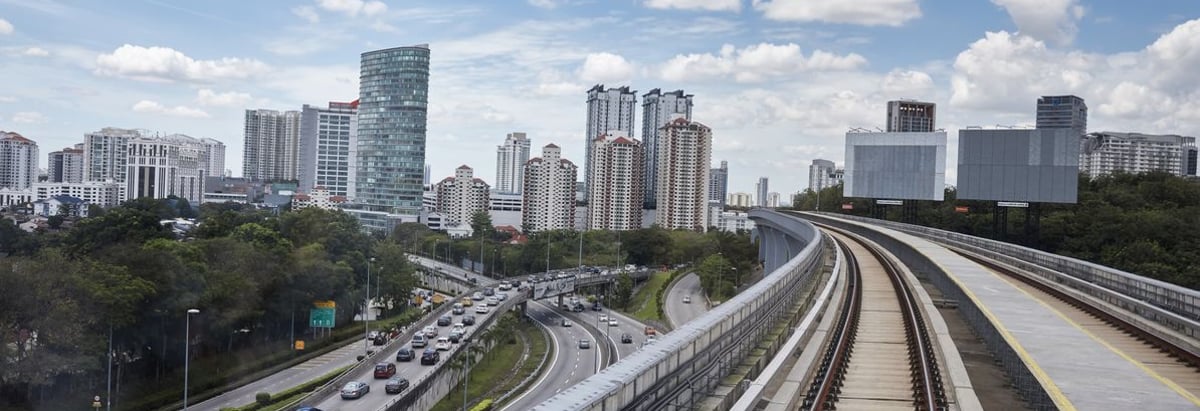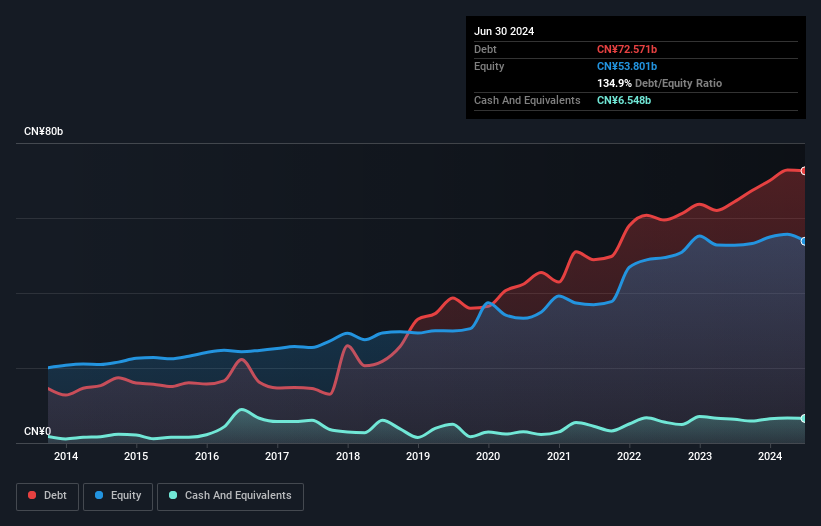
Warren Buffett famously said, 'Volatility is far from synonymous with risk.' So it seems the smart money knows that debt - which is usually involved in bankruptcies - is a very important factor, when you assess how risky a company is. We note that Shandong Hi-speed Company Limited (SHSE:600350) does have debt on its balance sheet. But the more important question is: how much risk is that debt creating?
What Risk Does Debt Bring?
Debt and other liabilities become risky for a business when it cannot easily fulfill those obligations, either with free cash flow or by raising capital at an attractive price. In the worst case scenario, a company can go bankrupt if it cannot pay its creditors. However, a more common (but still painful) scenario is that it has to raise new equity capital at a low price, thus permanently diluting shareholders. Of course, debt can be an important tool in businesses, particularly capital heavy businesses. When we think about a company's use of debt, we first look at cash and debt together.
Check out our latest analysis for Shandong Hi-speed
How Much Debt Does Shandong Hi-speed Carry?
The image below, which you can click on for greater detail, shows that at June 2024 Shandong Hi-speed had debt of CN¥72.6b, up from CN¥64.3b in one year. However, because it has a cash reserve of CN¥6.55b, its net debt is less, at about CN¥66.0b.

A Look At Shandong Hi-speed's Liabilities
Zooming in on the latest balance sheet data, we can see that Shandong Hi-speed had liabilities of CN¥32.7b due within 12 months and liabilities of CN¥68.3b due beyond that. Offsetting this, it had CN¥6.55b in cash and CN¥14.5b in receivables that were due within 12 months. So it has liabilities totalling CN¥79.9b more than its cash and near-term receivables, combined.
This deficit casts a shadow over the CN¥42.5b company, like a colossus towering over mere mortals. So we definitely think shareholders need to watch this one closely. After all, Shandong Hi-speed would likely require a major re-capitalisation if it had to pay its creditors today.
In order to size up a company's debt relative to its earnings, we calculate its net debt divided by its earnings before interest, tax, depreciation, and amortization (EBITDA) and its earnings before interest and tax (EBIT) divided by its interest expense (its interest cover). This way, we consider both the absolute quantum of the debt, as well as the interest rates paid on it.
Strangely Shandong Hi-speed has a sky high EBITDA ratio of 7.2, implying high debt, but a strong interest coverage of 16.6. So either it has access to very cheap long term debt or that interest expense is going to grow! Unfortunately, Shandong Hi-speed saw its EBIT slide 8.8% in the last twelve months. If that earnings trend continues then its debt load will grow heavy like the heart of a polar bear watching its sole cub. The balance sheet is clearly the area to focus on when you are analysing debt. But ultimately the future profitability of the business will decide if Shandong Hi-speed can strengthen its balance sheet over time. So if you want to see what the professionals think, you might find this free report on analyst profit forecasts to be interesting.
Finally, a business needs free cash flow to pay off debt; accounting profits just don't cut it. So we clearly need to look at whether that EBIT is leading to corresponding free cash flow. Over the last three years, Shandong Hi-speed recorded negative free cash flow, in total. Debt is far more risky for companies with unreliable free cash flow, so shareholders should be hoping that the past expenditure will produce free cash flow in the future.
Our View
On the face of it, Shandong Hi-speed's net debt to EBITDA left us tentative about the stock, and its level of total liabilities was no more enticing than the one empty restaurant on the busiest night of the year. But on the bright side, its interest cover is a good sign, and makes us more optimistic. We should also note that Infrastructure industry companies like Shandong Hi-speed commonly do use debt without problems. Taking into account all the aforementioned factors, it looks like Shandong Hi-speed has too much debt. That sort of riskiness is ok for some, but it certainly doesn't float our boat. When analysing debt levels, the balance sheet is the obvious place to start. However, not all investment risk resides within the balance sheet - far from it. For example Shandong Hi-speed has 2 warning signs (and 1 which makes us a bit uncomfortable) we think you should know about.
If you're interested in investing in businesses that can grow profits without the burden of debt, then check out this free list of growing businesses that have net cash on the balance sheet.
New: Manage All Your Stock Portfolios in One Place
We've created the ultimate portfolio companion for stock investors, and it's free.
• Connect an unlimited number of Portfolios and see your total in one currency
• Be alerted to new Warning Signs or Risks via email or mobile
• Track the Fair Value of your stocks
Have feedback on this article? Concerned about the content? Get in touch with us directly. Alternatively, email editorial-team (at) simplywallst.com.
This article by Simply Wall St is general in nature. We provide commentary based on historical data and analyst forecasts only using an unbiased methodology and our articles are not intended to be financial advice. It does not constitute a recommendation to buy or sell any stock, and does not take account of your objectives, or your financial situation. We aim to bring you long-term focused analysis driven by fundamental data. Note that our analysis may not factor in the latest price-sensitive company announcements or qualitative material. Simply Wall St has no position in any stocks mentioned.
About SHSE:600350
Shandong Hi-speed
Engages in the investment, operation, and management of toll roads, bridges, and tunnel infrastructure; and related businesses in China.
Established dividend payer and slightly overvalued.
Market Insights
Community Narratives



